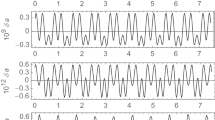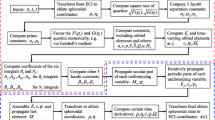Abstract
The author's second-order artificial satellite theory (Aksnes, 1970) is reviewed and compared with that of Kozai (1962). These theories differ in that the former makes use of: (1) an intermediate orbit, being a rotating ellipse instead of a fixed ellipse, (2) Hill variables instead of Delaunay variables, and (3) Hori's perturbation method in Lie series rather than Von Zeipel's method in Taylor series.
It is demonstrated that because of these differences, the former theory enjoys a greater simplicity and compactness, it is non-singular at zero eccentricity, and the process of deriving the perturbations is considerably simplified (Aksnes, 1972). For example, the number of second-order short-period terms due to the planet's oblateness (J 2) is reduced by a factor of about three (Hori, 1970). The intermediate orbit and Hori's perturbation method contribute about equally to this reduction.
Similar content being viewed by others
References
Aksnes, K.: 1970,Astron. J. 75, 1066.
Aksnes, K.: 1972,Astron. Astrophys. 17, 70.
Hori, G.: 1970, ‘Second-Order Solution of the Artificial Satellite Problem’, paper read by B. Garfinkel at the IAU Colloquium, Analytical Methods for Orbits of the Artificial Celestial Bodies, at Brighton, England, August 18–27, 1970.
Kozai, Y.: 1962,Astron. J. 67, 446.
Author information
Authors and Affiliations
Rights and permissions
About this article
Cite this article
Aksnes, K. On the choice of reference orbit, canonical variables, and perturbation method in satellite theory. Celestial Mechanics 8, 259 (1973). https://doi.org/10.1007/BF01231425
Issue Date:
DOI: https://doi.org/10.1007/BF01231425




